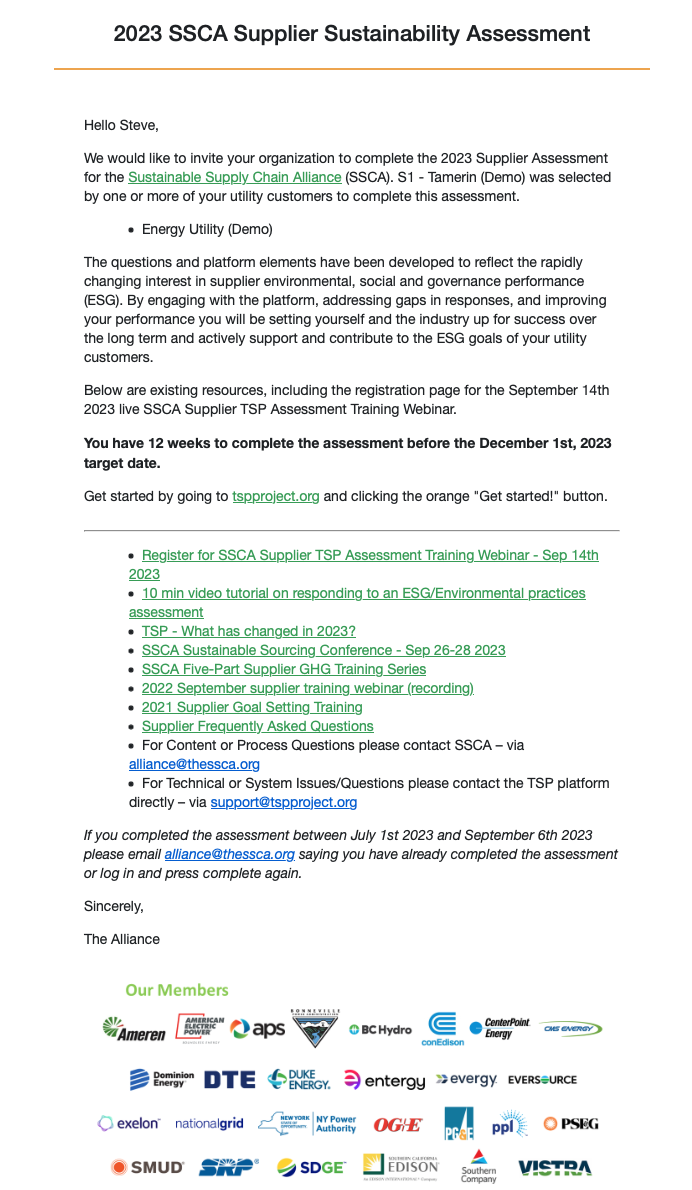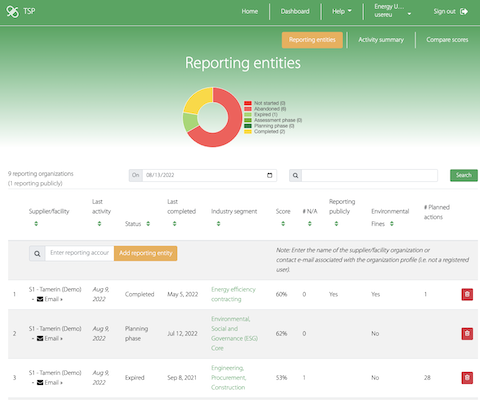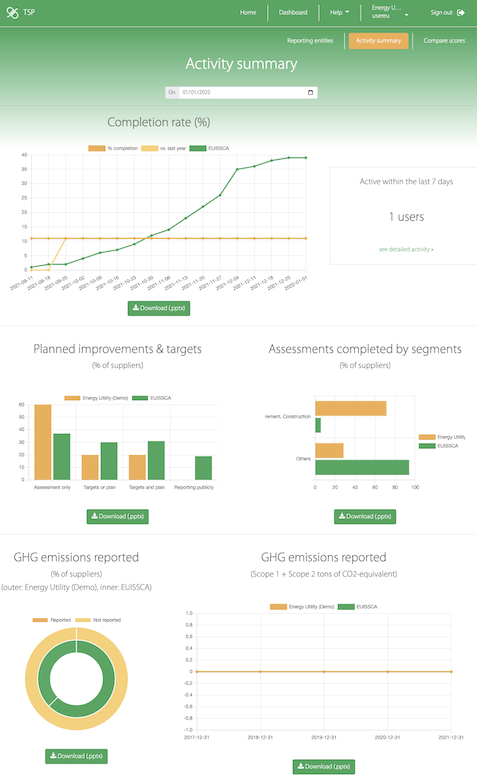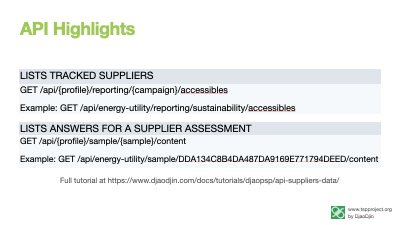Frequently Asked Questions
- General
- I have received a request to answer the ESG/Environmental practices questionnaire. What Next?
- Why did I get a "Company X requested your scorecard on TSP" email?
- Why did I get a "You were added as a profile manager..." email?
- How do I pick the industry segment that applies to my organization?
- Why was TSP developed?
- Don't see what you're looking for?
- Assessment
- Scorecard
- Reporting dashboard
- Industry-specific Environmental Practices
- Technical
General
I have received a request to answer the ESG/Environmental practices questionnaire. What next?
TSP (tspproject.org) helps organizations gain a better understanding of how their valued suppliers are considering and managing environmental impacts and opportunities, in order to identify and address opportunities to create a more sustainable supply chain.
If you have received a request to answer the sustainability questions as part of a bid package, sourcing event, or as part of an annual assessment, please follow the Responding to a questionnaire.
Resources listed in the 2023 SSCA Supplier Sustainability Assessment invite e-mail:
- 2023 September SSCA training webinar (PDF slides)
- 10 min video tutorial on responding to an ESG/Environmental practices assessment
- TSP - What has changed in 2023?
- SSCA Sustainable Sourcing Conference - Sep 26-28 2023
- SSCA Five-Part Supplier GHG Training Series
- 2021 Supplier Goal Setting Training
- Supplier Frequently Asked Questions
- For any questions, comments or general feedback, please contact us.

Why did I get a "Company X requested your scorecard on TSP" email?
-
A current or prospective client/customer/investor is using TSP as their platform for evaluating supplier maturity in environmental management (e.g. as part of an RFP process, or a socially responsible investment strategy).
If you have already completed an assessment on TSP, you can go ahead and share your scorecard with the requester.
If this was the first time you have been invited to take an assessment on TSP, review the short tutorials for help on how to take an assessment and share your resulting scorecard.
Why did I get a "You were added as a profile manager..." email?
-
The person who triggered the email to you is a Profile Manager of your organization’s information on TSP. They wish to grant you similar access rights on the system to theirs.
As a Profile Manager, you have access to the core functions of the site i.e.:
- Learn - Browse practices applicable to your industry segment.
- Measure - Complete an assessment of your organization against practices and see how you benchmark with peers.
- Improve - Select high value improvement actions to implement.
As a Profile Manager, you also have administrative access to the site, which allow you to invite other parties to be:
- Profile Managers.
- Contributors - who can help complete the Self Assessment and Improvement Planning information.
- Viewers - who can review the information in the profile without altering it.
The person who triggered the email should follow-up with you to explain why they are inviting you to be a Profile Manager. To learn more about the functions of TSP on your own, browse the tutorials.
How do I pick the industry segment that applies to my organization?
-
Industry segment Examples Architectural design Organizations categorized under NAICS code 54131 (Architectural Services), NAICS code 54132 (Landscape Architectural Services). Aviation services Aerial leak detection
Aerial transportation
Helicopter services
Line inspections
Line cleaning
Organizations categorized under NAICS code 481219 (Other Nonscheduled Air Transportation), 487990 (Scenic and Sightseeing Transportation)Construction Building/facilities construction
Hard surface installation/repair
Overhead construction
Underground construction
Organizations categorized under NAICS code 237 (Heavy and Civil Engineering Construction), 238 (Specialty Trade Contractors), 23620 (Commercial and Institutional Building Construction).Consulting/ Advisory services Legal services
Accounting and other financial services
Management consulting
Human resources advisory services
Health care advisory services
Organizations categorized under NAICS code 54 (Professional, Scientific, and Technical Services)Distribution/Logistics & shipping Chemical distributor
Components, equipment, instruments, parts, tools distributor
Organizations categorized under NAICS code 493 (Warehousing and Storage), 541614 (Process, Physical Distribution, and Logistics Consulting Services), 488510 (Freight Transportation Arrangement), 48899 (Other Support Activities for Transportation).Energy efficiency contracting Organizations categorized under NAICS code 541690 (Other Scientific and Technical Consulting Services) Engineering Organizations categorized under NAICS code 541330 (Engineering Services) Engineering, procurement, construction Organizations categorized under NAICS code 237 (Heavy and Civil Engineering Construction), 236220 (Commercial and Institutional Building Construction), 541330 (Engineering Services). Enviro. consulting, engineering, construction Environmental impact assessment
Environmental planning
Environmental advisory services
Environmental licensing & permitting
Environmental site remediation
Organizations categorized under NAICS code 541690 (Other Scientific and Technical Consulting Services).Facilities management Building/ facilities leasing
Building/facilities management
Building/facilities maintenance and repair
Custodial/janitorial services
Outdoor maintenance
Grounds management
Organizations categorized under NAICS code 561210 (Facilities Support Services).Freight & shipping Air freight and shipping
Ground freight and shipping
Small parcel shipping
Organizations categorized under NAICS code 321920 (Wood Container and Pallet Manufacturing), 484121 (General Freight Trucking, Long-Distance, Truckload), 488510 (Freight Transportation Arrangement).Fuel supply General contracting Drilling
Escavation
Fencing
Maintenance, repairs and operation (MRO)
Mark and location services
General maintenance and repairs (machinery, overhead, underground)
Groundworks
Location services
Millwright
Outdoor lighting & maintenance
Pole installation/removal, checking, repair
Underground work
Organizations categorized under NAICS code 238 (Specialty Trade Contractors).Interior design Organizations categorized under NAICS code 541410 (Interior Design Services). Lab services Organizations categorized under NAICS code 541380 (Testing Laboratories) Marketing & communications Advertising services
Marketing services
Organizations categorized under NAICS code 541613 (Marketing Consulting Services).Metal structures & equipment
Boxes & enclosuresOrganizations categorized under NAICS code 3323 (Architectural and Structural Metals Manufacturing). Metal structures & equipment
Distribution transformersOrganizations categorized under NAICS code 3323 (Architectural and Structural Metals Manufacturing). Metal structures & equipment
Fabricated metalsOrganizations categorized under NAICS code 3323 (Architectural and Structural Metals Manufacturing). Metal structures & equipment
General manufacturingOrganizations categorized under NAICS code 3323 (Architectural and Structural Metals Manufacturing). Metal structures & equipment
Wire & cableOrganizations categorized under NAICS code 3323 (Architectural and Structural Metals Manufacturing). Print services Organizations categorized under NAICS code 323111 (Commercial Printing, except Screen and Books), 561439 (Other Business Service Centers, including Copy Shops). Professional services Background check services
Call center services
Customer care
Event planning
Laundry services (excepting, nuclear contaminated clothing)
Healthcare services
IT services
Office equipment maintenance and repair
Payroll services
Recruitment services
Staff augmentation
Traffic control/management
Travel management
Organizations categorized under NAICS code 541690 (Other Scientific and Technical Consulting Services).Equipment & parts rental/leasing Automotive leasing
Construction and other heavy equipment rental
Scaffolding
Organizations categorized under NAICS code 532490 (Other Commercial and Industrial Machinery and Equipment Rental and Leasing).Value added reselling Automotive sales
Computer and telecom equipment
Distribution products/equipment
Office supplies
Promotional items sales
Safety equipment
Tools, controls, measuring equipment
Transmission products/equipment
Vehicles
Organizations categorized under NAICS code 423850 (Service Establishment Equipment and Supplies Merchant Wholesalers), 424120 (Stationery and Office Supplies Merchant Wholesalers), 444130 (Hardware Stores), 453210 (Office Supplies and Stationery Stores).Vegetation management Line clearance
Tree cutting
Tree removal
Vegetation clearance and management
Organizations categorized under NAICS code 238 (Specialty Trade Contractors), 562910 (Remediation Services).Waste management General waste hauling and disposal
Investment recovery
Hazardous waste hauling and disposal
Recycling services
Organizations categorized under NAICS code 562 (Waste Management and Remediation Services). - Still can’t see your industry segment? Contact us.
Why was TSP developed?
-
TSP has three main objectives:
- Learning: To make identifying and prioritizing environmental practices easier and industry specific.
- Measuring: To provide benchmarking and meaningful measurement of an organization’s environmental performance.
- Improving: To enable improvement planning based on environmental and business value.
- Any organization. For organizations beginning the process of implementing environmental sustainability measures, the process of identifying and prioritizing environmental issues can be complex, expensive and time consuming. TSP aims to make that process easier by providing industry segment-specific practices that are prioritized by environmental and business value. It also provides tools for self-assessment and benchmarking, and planning tools to help identify improvement opportunities based on environmental and business value.
- Managers of multiple reporting entities (e.g. suppliers, owned facilities). The TSP capabilities described above can be used to accelerate the adoption of sustainability practices by a target group. TSP also provides meaningful measures of quality and maturity of sustainability management for evaluation and reporting purposes (e.g. RFP, assessments, scorecards).
To evaluate and promote environmental sustainability best practices, this website relies on a transparent government process.
The source code for the website is Open Source; you can review yourself how scores are computed. The best practices content is available under a Creative Common License; you are free to copy, use and distribute what you read of this website.
Unless you specify the release of data, all information you provide for benchmarking purposes is treated as confidential and anonymous and displayed only in aggregated format.
We encourage you to read the terms of service for details. If you want to participate in the governance of this site, please contact us.
Don’t see what you’re looking for?
- Contact us with your question.
ESG/Environmental practices
How were practices for each industry segment identified or selected?
-
The ESG/Environmental practices questionnaire is structured as a set of ESG management core questions and a set of industry-focused environmental practices suited to implement actionable steps that will improve the organization sustainability posture.
Questions and practices were selected on the basis of their being leading indicators of the quality and maturity of an organization’s environmental sustainability management. Practices were compiled and peer-reviewed by cross-functional industry and sustainability subject matter experts.
TSP Content Governance sets forth steps, timing, roles and responsibilities for ensuring a rigorous and transparent process by which content is developped, reviewed and vetted. All original questions and practices, as well as yearly updates, are made available under a Creative Commons ( CC BY-SA) license. In short you can copy, modify, and redistribute the content as long as you give credit to this Website.
Learn more about the structure of the ESG/Environmental practices questionnaire »
How are environmental and business values assigned to practices?
-
A value ranking system is used to assign environmental and business values to a best practice. Values are based on order-of-magnitude-level estimates of the potential value of implementing a best practice to its full extent and applicable scope. They are intended to provide high level ranking of practices, rather than precise estimates.
The TSP Content Governance sets forth steps, timing, roles and responsibilities for ensuring a rigorous and transparent process by which value ranking is developped, reviewed and vetted.
The actual value realized by an organization from implementing a best practice will vary widely due to a number of factors, including, but not limited to, size of the organization, number and scale of projects, nature of activities or operations, geographic region, and best practice implementation extent and scope. If you have experience that indicates any of the assigned values would benefit from recalibration, please contact us so that we may refine the value(s) in question.
Are practices on TSP subject to change?
-
practices may be updated based on information brought to the attention of TSP by users and content contributors. A formal transparent review cycle is scheduled every three years in accordance with TSP Content Governance.
Who can add practices and best practice guidance?
- Anyone with subject matter expertise in environmental practices related to an industry segment may contribute content to TSP. Contact us if you are interested doing so.
How will I know if new practices relevant to me are added to TSP?
- You will receive an email alert about any new practices or best practice guidance added to TSP associated with your industry segment.
How was the GHG Emissions Estimator Tool created?
-
TSP GHG Emissions Estimator Tool is a Web-based implementation of the spreadsheets made available publicly by the Green House Protocol. The Green House Protocol spreadsheet-based tool is considered one of the most accurate GHG Emissions Estimator tool available publicly.
If you are curious, or want to verify the correctness of TSP's Web-based implementation, you can find the source code available as Open Source on GitHub.
Assessment
How frequently does an Assessment need to be completed?
- The full Assessment gets completed once. This creates a baseline record against which you may record any improvements you make over time.
If practices are added to TSP, will that affect my Assessment results?
- No. There will no change your baseline score, or any subsequent improved scores. New practices and your score against same will only be factored in to the next Assessment update you choose to record in the system.
Explain the “Opportunity score” shown on the Assessment results page?
- Opportunity scores for a best practice represent the number of points by which you could increase your total points by implementing the practice. The total score (presented in the Scorecard) is your total points divided by the total number of points available for capture. Calculation used to derive opportunity score: Opportunity score = (value assigned to a best practice) x ( 1 + implementation rate ) x (3 – value assigned to your response to the question "Is this practice implemented?")
- Note: Using this methodology means that the opportunity score for any best practice will increase as the implementation rate for a practice increases (as new users complete the assessment and report implementing the practice). This results in a minor bias against early adoption of a practice; however, testing showed the bias to be negligible.
Scorecard
How does scoring work?
- Scores are assigned on the following basis:
- Score for a single best practice: Your score for a best practice is calculated by multiplying the value assigned to the practice by the value assigned to your response to the question “Is this implemented as standard practice?” (See table below for values).
- Score for a section of practices: practices are grouped into sections (e.g. Electricity/gas, Fuel, Waste/pollution). The scores for each best practice are used to calculate your percentage score for that section. Each section is also assigned a weight to indicate its relative significance against other sections.
- Total score: Sum of the totals for each section multiplied by their weight.
- Note: Your scores will change slightly as more respondents complete the Assessment for an industry segment.
Values assigned to a best practice to indicate relative value Values assigned to responses to the question "Is this practice implemented?" Gold 6 Yes 3 Dark green 3 Mostly yes 2 Medium green 2 Mostly no 1 Light green 1 No 0
How does benchmarking work?
- Your relative position against peers in your industry segment is shown in the “Benchmark graph” section of your Scorecard. Benchmark positions may change over time as more respondents from your industry peer group respond to the Assessment, so it is important to check back into the system from time to time to monitor for updates in the benchmark outcome.
How to read a supplier assessment?
-
A Environmental, Social and Governance (ESG) Core scorecard is composed of 4 parts:
- Summary section
- Qualitative assessment
- Data & metrics
- Targets
The summary section gives a quick bird-eye view on key answers. Qualitative assessment contains the list of Yes/No question with the supplier answers and comments. The Data & metrics tables show reported environmental metrics (GHG emissions, waste and water). The Targets section contains the stated ESG targets for the supplier.
You can read more details in this tutorial.
Reporting dashboard
What does the status column mean?
-
The Status column shows how far along a supplier has completed the assessment.
- Not started: Registered but has not started Assessment. Typically, this indicates a supplier is registered but has never answered a question on the assessment.
- Abandoned: A supplier started an assessment and/or improvement plan but never completed or submitted it within the last 12 months.
- Expired: A supplier has submitted both a complete assessment and improvement plan, but it was more than 12 months ago.
- Assessment phase: Assessment is in progress. Once a supplier clicks the "Complete" button to submit their definitive answers for the year, their status moves from the assessment phase to the planning phase.
- Planning phase: A supplier has submitted a complete assessment and is now creating an improvement plan. Once a supplier clicks the "Complete" button to submit their definitive improvement plan for the year, their status moves from the planning phase to completed.
- Completed: A supplier has submitted both a complete assessment and improvement plan for the year.
How are reporting status computed?
-
Both, the On date and Expired before date will affect the status of reporting entity.
- All suppliers that are still on the dashboard after the On date are included. For those suppliers, the latest response before the On date is shown.
- The latest supplier response is then compared to the Expired before date. If the supplier response is older than the Expired before date, it is marked Abandoned or Expired.
For example, Steve's Shop is a supplier to Energy Utility that answered the assessment on Nov 10th 2018 and again on Oct 2nd 2019. After review Energy Utility decided on Apr 1st 2019 that Steve's Shop is not a high impact supplier after all and wouldn't be required to answer yearly assessments going forward.
When a Energy Utility supplier manager selects the following dates, the dashboard is updated as follows:
On Dec 1st 2018, Expired before Sep 1st 2018 Steve's Shop Nov 10th 2018 assessment is showing on the dashboard as Completed. On Dec 1st 2019, Expired before Sep 1st 2019 Steve's Shop is not showing on the dashboard because it was removed on Apr 1st 2019. On Mar 31st 2019, Expired before Dec 1st 2018 Steve's Shop Nov 10th 2018 assessment is showing on the dashboard as Expired because it was completed before Dec 1st 2018.
How to find the latest completed assessments?
-
On the Reporting entities dashboard, you can sort suppliers by Last completed. Click on the double-arrows in the Last completed column header until you see a single arrow pointing up. The suppliers at the top will be the latest suppliers to have completed an assessment.
Furthermore, if you want to track suppliers that have completed the assessment after a certain date (ex: Sep 1st 2022), enter that date in the Expired before input field at the bottom of the page and click Save preferences. You can then sort by the Status column. Suppliers who have completed an assessment after the expired date will show as the top.

How to find if a supplier logged in after I contacted them?
-
On the Reporting entities dashboard, you can sort suppliers by Last activity. Click on the double-arrows in the Last activity column header until you see a single arrow pointing up. The suppliers at the top will be the latest suppliers to have made some updates to their assessment. When the Last activity is newer than the Last completed date, the supplier is in the process of updating their assessment.
It is also possible someone at the supplier logged in but hasn't done any updates to the assessment yet. To review the suppliers that have been logged in within the last 7 days, go to Activity summary, and click on see detailed activity.

Technical
Will the data provided be shared? With who?
-
The purpose of The Sustainability Project (TSP) is to promote sustainability best practices across entire supply chains. The data provided is not used for any other purposes.
The answers to the ESG/Environmental practices questionnaire are anonymized and aggregated so you can compare your own organization against peers responding to the questionnaire.
In order to provide high-quality baselines and comparison charts, TSP has independent third-party data verifiers review answers and supporting documentation to grade the confidence in supplier responses. This process enables your customers to respond to CDP and other reporting agencies.
TSP encourages you to provide any supporting documentation as public links to a Website you own whenever possible (ex: your organization’s public sustainability report).
The detailed individual answers, comments, and uploaded documentation are only shared with the organizations you elect. All customers you have shared information with are available by clicking the Historical assessments link in the Assess section after you log in. These customers will have access to your completed response, exactly as it appears on the REVIEW step.
If you need to show your organization responded to the assessment, but do not wish to share the response with customers, you can also do so by clicking “Complete”, and then denying a customer request to access your organization's detailed response. The customer will see that your organization has responded (and thus can count it in their supplier engagement numbers), but will not have access to the detailed response.
TSP advises customers you share information with to keep it confidential, but cannot enforce they will do so. Therefore we recommend you upload documents that require a reasonable expectation of confidentiality, but nothing that could be considered business trade secrets.
For more uses of the data provided by customers, please contact your customers directly. We will provide you with your customers' primary contact for TSP upon request. A primary contact will be able to answer your questions with regards to the customer internal process, and their intended use of the data provided.
For any questions, please contact us.
How is data provided secured?
-
TSP uses both technical solutions and data management policies to insure information is only accessed by authorized users and entities.
All hosting machines are located in the United States. All data is encrypted, both at-rest and in-transit. Data access is checked on each request by a RBAC gateway. Access is only granted once a user session passes a set of explicit and easily auditable access rules.
All users must have a unique login per the terms of use. Accounts sharing is not allowed. Registering as many users for your organization as necessary to manage the reporting process is free. If you want to connect your organization profile to a SSO provider, please contact us.
For more details, see Security policy.
Supplier 1 Supplier 2 Customer A Customer B Supplier 1 assess Supplier 2 assess Supplier 1 scorecard with double opt-in with double opt-in Supplier 2 scorecard with double opt-in with double opt-in Customer A dashboard Customer B dashboard Aggregate trends GEOGRAPHICAL LOCATION
All hosting machines are located in the United States.
ENCRYPTED DATA IN TRANSIT
All HTTP requests to tspproject.org are done through TLS.
ENCRYPTED DATA AT REST
EBS disk volumes on which databases are stored is encrypted using the industry-standard AES-256 algorithm.
ROLE-BASED ACCESS CONTROL (RBAC)
User session management is implemented through an enterprise-grade RBAC gateway.
Is there any API access?
-
Being built on Open Source, and a Practices Survey Platform that powers a portfolio of Web properties, all TSP features are available through API endpoints.
To learn more you can download the TSP API presentation below (PDF), and/or browse a tutorial on API Access to suppliers assessments.

